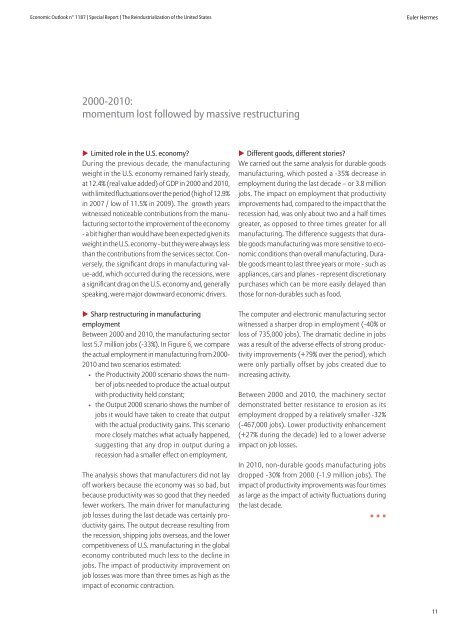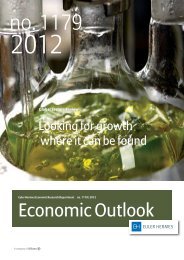Reindustrialization in USA - Euler Hermes
Reindustrialization in USA - Euler Hermes
Reindustrialization in USA - Euler Hermes
Create successful ePaper yourself
Turn your PDF publications into a flip-book with our unique Google optimized e-Paper software.
Economic Outlook n° 1187 | Special Report | The <strong>Re<strong>in</strong>dustrialization</strong> of the United States<strong>Euler</strong> <strong>Hermes</strong>2000-2010:momentum lost followed by massive restructur<strong>in</strong>gu Limited role <strong>in</strong> the U.S. economy?Dur<strong>in</strong>g the previous decade, the manufactur<strong>in</strong>gweight <strong>in</strong> the U.S. economy rema<strong>in</strong>ed fairly steady,at 12.4% (real value added) of GDP <strong>in</strong> 2000 and 2010,with limited fluctuations over the period (high of 12.9%<strong>in</strong> 2007 / low of 11.5% <strong>in</strong> 2009). The growth yearswitnessed noticeable contributions from the manufactur<strong>in</strong>gsector to the improvement of the economy- a bit higher than would have been expected given itsweight <strong>in</strong> the U.S. economy - but they were always lessthan the contributions from the services sector. Conversely,the significant drops <strong>in</strong> manufactur<strong>in</strong>g value-add,which occurred dur<strong>in</strong>g the recessions, werea significant drag on the U.S. economy and, generallyspeak<strong>in</strong>g, were major downward economic drivers.u Sharp restructur<strong>in</strong>g <strong>in</strong> manufactur<strong>in</strong>gemploymentBetween 2000 and 2010, the manufactur<strong>in</strong>g sectorlost 5.7 million jobs (-33%). In Figure 6, we comparethe actual employment <strong>in</strong> manufactur<strong>in</strong>g from 2000-2010 and two scenarios estimated:• the Productivity 2000 scenario shows the numberof jobs needed to produce the actual outputwith productivity held constant;• the Output 2000 scenario shows the number ofjobs it would have taken to create that outputwith the actual productivity ga<strong>in</strong>s. This scenariomore closely matches what actually happened,suggest<strong>in</strong>g that any drop <strong>in</strong> output dur<strong>in</strong>g arecession had a smaller effect on employment.The analysis shows that manufacturers did not layoff workers because the economy was so bad, butbecause productivity was so good that they neededfewer workers. The ma<strong>in</strong> driver for manufactur<strong>in</strong>gjob losses dur<strong>in</strong>g the last decade was certa<strong>in</strong>ly productivityga<strong>in</strong>s. The output decrease result<strong>in</strong>g fromthe recession, shipp<strong>in</strong>g jobs overseas, and the lowercompetitiveness of U.S. manufactur<strong>in</strong>g <strong>in</strong> the globaleconomy contributed much less to the decl<strong>in</strong>e <strong>in</strong>jobs. The impact of productivity improvement onjob losses was more than three times as high as theimpact of economic contraction.u Different goods, different stories?We carried out the same analysis for durable goodsmanufactur<strong>in</strong>g, which posted a -35% decrease <strong>in</strong>employment dur<strong>in</strong>g the last decade – or 3.8 millionjobs. The impact on employment that productivityimprovements had, compared to the impact that therecession had, was only about two and a half timesgreater, as opposed to three times greater for allmanufactur<strong>in</strong>g. The difference suggests that durablegoods manufactur<strong>in</strong>g was more sensitive to economicconditions than overall manufactur<strong>in</strong>g. Durablegoods meant to last three years or more - such asappliances, cars and planes - represent discretionarypurchases which can be more easily delayed thanthose for non-durables such as food.The computer and electronic manufactur<strong>in</strong>g sectorwitnessed a sharper drop <strong>in</strong> employment (-40% orloss of 735,000 jobs). The dramatic decl<strong>in</strong>e <strong>in</strong> jobswas a result of the adverse effects of strong productivityimprovements (+79% over the period), whichwere only partially offset by jobs created due to<strong>in</strong>creas<strong>in</strong>g activity.Between 2000 and 2010, the mach<strong>in</strong>ery sectordemonstrated better resistance to erosion as itsemployment dropped by a relatively smaller -32%(-467,000 jobs). Lower productivity enhancement(+27% dur<strong>in</strong>g the decade) led to a lower adverseimpact on job losses.In 2010, non-durable goods manufactur<strong>in</strong>g jobsdropped -30% from 2000 (-1.9 million jobs). Theimpact of productivity improvements was four timesas large as the impact of activity fluctuations dur<strong>in</strong>gthe last decade.• • •11












